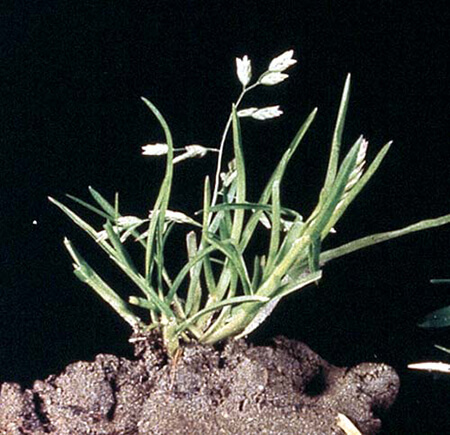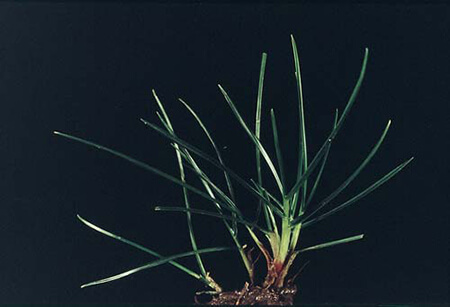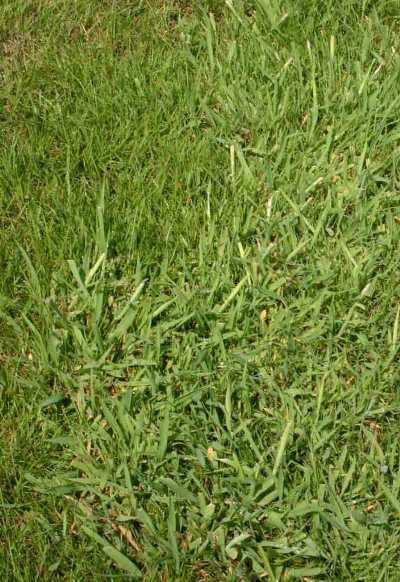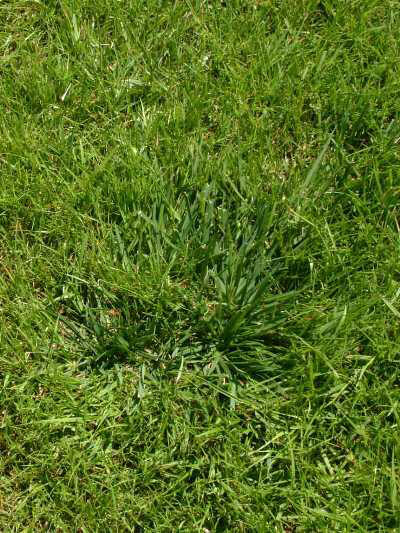How to Get Rid of Wild Grass in Lawn
Weed and rough grasses, like broad leaved weeds readily take advantage of weaknesses in your lawn. They are also well suited to loam or clay loam soils particularly as most are fairly neutral in acidity/alkalinity. This means keeping them out is impossible though once again a thick healthy turf will provide a very useful barrier.
All are in abundance in verges, fields and the countryside. Controlling them is only worthwhile in a few cases;
Annual Meadow Grass and Rye Grass
 Annual Meadow Grass
Annual Meadow Grass
 Rye Grass
Rye Grass
Annual meadow grass (medium green leaf with seed heads present all year round- top image) and rye grass (darker green, leaves dull on top and shiny underneath with tall seed spikes or soldiers).
These make for reasonable lawns and may well go unnoticed in anything other than an ornamental lawn. Golf courses are full of them and are only controlled on greens by hand pulling young plants, regular vertical mowing (like fine scarifying) or renovation by deep scarifying and overseeding.
Both thrive on well or even over fertilised ground and annual meadow grass dominates over other grasses when watering lightly as it has shallow roots. When creating a new lawn switch to deep and infrequent watering as soon as possible after the lawn has established.
Yorkshire Fog

The next weed grass is Yorkshire Fog. A broad soft pale green slightly hairy leaf mistakenly called 'couch grass' or 'crab grass' can be quite a problem. Because it forms clumps its colour and broad leaves make it quite noticable when it reaches a certain size. In addition, it doesn't green up very well when using fertiliser so when your normal grass darkens this stays pale green thereby making it even more noticable.
Not everyone is bothered by it but if you are then control by cutting out individual plants as they occur or replacing clumps with seed or turf. It is a very delicate grass and any form of abrasion (slash it vertically with a spade OR abrade it with a spring tine rake or scarifier) will weaken it. Unfortunately this can be a slow and laborious process so cutting out the grass is usually the best option.
If clumps are particularly large then use glyphosate (Roundup) to kill it, after a couple of weeks thoroughly rake to remove the dead grass and then re-seed. To ensure the repair merges well with your existing grass, rake some good grass well outside the patch area and over seed this and the patch. This will help blend the new and old grasses without any hard edges.
Finally, if your lawn is covered in it best to bite the bullet, kill off the whole lawn, remove the turf, ideally dig or rotovate the soil and then re-seed. See Creating a New Lawn
Rough Meadow Grass

Finally, the worst of the weed grasses is the least common and easiest to sort. Also known as Rough Stalked Meadow Grass this grass forms dense clumps or 'whorls' of very rough stiff broad dark green grass.
It is very obvious in any lawn and should be removed as soon as it is spotted as the clumps will just get bigger. Small patches or individual plants can be pulled out, broken off or cut out with a knife and clumps can be replaced with new seed or turf.
Rough stalked meadow grass is also a useful grass for shady areas. However, this would be a variety that has had a little scientific breeding to make it a useful and reasonably attractive addition to your lawn. The 'wild' variety invading your lawn is 'orrible stuff!
The incidence of the latter two grasses seems to have increased in recent years. There is some talk within the industry that this may be a consequence of more extreme weather with extended and unbroken periods of either rain or drought. Until we know for sure one way or the other keeping a healthy lawn will always help reduce weeds and weed grasses.
How to Get Rid of Wild Grass in Lawn
Source: https://www.lawnsmith.co.uk/lawn-care-advice/lawn-weed-control/weed-grasses-in-lawns
0 Response to "How to Get Rid of Wild Grass in Lawn"
Post a Comment